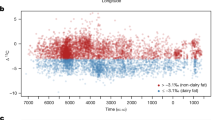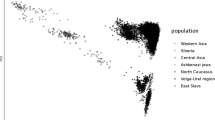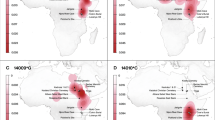Abstract
The ability of humans to digest the milk component lactose after weaning requires persistent production of the lactose-converting enzyme lactase. Genetic variation in the promoter of the lactase gene (LCT) is known to be associated with lactase production and is therefore a genetic determinant for either lactase deficiency or lactase persistence during adulthood. Large differences in this genetic trait exist between populations in Africa and the Middle-East on the one hand, and European populations on the other; this is thought to be due to evolutionary pressures exerted by consumption of dairy products in Neolithic populations in Europe. In this study, we have investigated lactase persistence of 26 out of 46 individuals from Late Neolithic through analysis of ancient South-West European DNA samples, obtained from two burials in the Basque Country originating from 5000 to 4500 YBP. This investigation revealed that these populations had an average frequency of lactase persistence of 27%, much lower than in the modern Basque population, which is compatible with the concept that Neolithic and post-Neolithic evolutionary pressures by cattle domestication and consumption of dairy products led to high lactase persistence in Southern European populations. Given the heterogeneity in the frequency of the lactase persistence allele in ancient Europe, we suggest that in Southern Europe the selective advantage of lactose assimilation in adulthood most likely took place from standing population variation, after cattle domestication, at a post-Neolithic time when fresh milk consumption was already fully adopted as a consequence of a cultural influence.
Similar content being viewed by others
Log in or create a free account to read this content
Gain free access to this article, as well as selected content from this journal and more on nature.com
or
Change history
01 July 2012
This article has been corrected since Advance Online Publication and a corrigendum is also printed in this issue
References
Bersaglieri T, Sabeti PC, Patterson N et al: Genetic signatures of strong recent positive selection at the lactase gene. Am J Hum Genet 2004; 74: 1111–1120.
Enattah NS, Trudeau A, Pimenoff V et al: Evidence of still-ongoing convergence evolution of the lactase persistence T-13910 alleles in humans. Am J Hum Genet 2007; 81: 615–625.
Nagy D, Tomory G, Csanyi B et al: Comparison of lactase persistence polymorphism in ancient and present-day Hungarian populations. Am J Phys Anthropol 2011.
Lewinsky RH, Jensen TG, Moller J, Stensballe A, Olsen J, Troelsen JT : T-13910 DNA variant associated with lactase persistence interacts with Oct-1 and stimulates lactase promoter activity in vitro. Hum Mol Genet 2005; 14: 3945–3953.
Enattah NS, Sahi T, Savilahti E, Terwilliger JD, Peltonen L, Jarvela I : Identification of a variant associated with adult-type hypolactasia. Nat Genet 2002; 30: 233–237.
Tishkoff SA, Reed FA, Ranciaro A et al: Convergent adaptation of human lactase persistence in Africa and Europe. Nat Genet 2007; 39: 31–40.
Simoons FJ : Primary adult lactose intolerance and the milking habit: a problem in biologic and cultural interrelations. II. A culture historical hypothesis. Am J Dig Dis 1970; 15: 695–710.
Beja-Pereira A, Luikart G, England PR et al: Gene-culture coevolution between cattle milk protein genes and human lactase genes. Nat Genet 2003; 35: 311–313.
Burger J, Kirchner M, Bramanti B, Haak W, Thomas MG : Absence of the lactase-persistence-associated allele in early Neolithic Europeans. Proc Natl Acad Sci USA 2007; 104: 3736–3741.
Malmström H, Linderholm A, Liden K et al: High frequency of lactose intolerance in a prehistoric hunter-gatherer population in northern Europe. BMC Evol Biol 2010; 10: 89–96.
Lacan M, Keyser C, Ricaut FX et al: Ancient DNA reveals male diffusion through the Neolithic Mediterranean route. Proc Natl Acad Sci USA 2011; 108: 9788–9791.
Aoki K : Theoretical and empirical aspects of gene-culture coevolution. Theor Popul Biol 2001; 59: 253–261.
Flatz G, Rotthauwe HW : Lactose nutrition and natural selection. Lancet 1973; 2: 76–77.
Izagirre N, de la Rua C : An mtDNA analysis in ancient Basque populations: implications for haplogroup V as a marker for a major Paleolithic expansion from southwestern Europe. Am J Hum Genet 1999; 65: 199–207.
Márquez B, Gibaja J, González Urquijo J, Ibáñez J, Palomo A : Projectile points as signs of violence in collective burials during the 4th and the 3rd millenium Cal. BC in the NE of the Iberian Peninsula. Digital.CSIC) 2009.
de la Rua C, Arriaga H : Dental pathologies in San Juan ante Portam Latinam and Longar (Final Neolithic - Chalcolithic). Cuadernos de Ciencias Médicas de la Sociedad de Estudios Vascos 2004; 6: 239–301.
Chikhi L, Nichols RA, Barbujani G, Beaumont MA : Y genetic data support the Neolithic demic diffusion model. Proc Natl Acad Sci USA 2002; 99: 11008–11013.
Lucotte G, Hazout S : Y-chromosome DNA haplotypes in Basques. J Mol Evol 1996; 42: 472–475.
Richards M, Macaulay V, Hickey E et al: Tracing European founder lineages in the Near Eastern mtDNA pool. Am J Hum Genet 2000; 67: 1251–1276.
Semino O, Passarino G, Oefner PJ et al: The genetic legacy of Paleolithic Homo sapiens sapiens in extant Europeans: a Y chromosome perspective. Science 2000; 290: 1155–1159.
Torroni A, Bandelt HJ, D’Urbano L et al: mtDNA analysis reveals a major late Paleolithic population expansion from southwestern to northeastern Europe. Am J Hum Genet 1998; 62: 1137–1152.
Torroni A, Bandelt HJ, Macaulay V et al: A signal, from human mtDNA, of postglacial recolonization in Europe. Am J Hum Genet 2001; 69: 844–852.
Gerbault P, Moret C, Currat M, Sanchez-Mazas A : Impact of selection and demography on the diffusion of lactase persistence. PLoS One 2009; 4: e6369.
Cooper A, Poinar HN : Ancient DNA: do it right or not at all. Science 2000; 289: 1139.
Hofreiter M, Serre D, Poinar HN, Kuch M, Paabo S : Ancient DNA. Nat Rev Genet 2001; 2: 353–359.
Gilbert MT, Bandelt HJ, Hofreiter M, Barnes I : Assessing ancient DNA studies. Trends Ecol Evol 2005; 20: 541–544.
Evershed RP, Payne S, Sherratt AG et al: Earliest date for milk use in the Near East and southeastern Europe linked to cattle herding. Nature 2008; 455: 528–531.
Altuna J, Mariezkurrena K : Types of livestock populations during the Neolithic in the Basque Country and surrounding areas; Tipos de cabañas ganaderas durante el Neolítico del País Vasco y zonas próximas. Archaeofauna 2009; 18: 137–157.
Clutton-Brock J : A Natural History of Domesticated Mammals. Cambridge: Cambridge University Press, 1999.
Garrard A, Colledge S, Martin L : The emergence of crop cultivation and caprine herding in the ‘Marginal Zone’ of the Southern Levant. The origin and spread of agriculture and pastoralism in Eurasia. University College London Press, 1996, p. 204–226.
Rollefson GO, Kohler-Rollefson I : Early Neolithic exploitation patterns in the Levant: cultural impact of the environment. Popul Environ 1992; 13: 243–254.
Sherratt A : The secondary exploitation of animals in the Old World. World Archaeol 1983; 15: 90–104.
Craig OE : The development of dairying in Europe: potential evidence from food residues on ceramics. Documenta Praehistorica 2002; 29: 97–107.
Spangenberg JE, Matuschik I, Jacomet S, Schibler J : Direct evidence for the existence of dairying farms in prehistoric Central Europe (4th millennium BC). Isotopes Environ Health Stud 2008; 44: 189–200.
Zapata L, Pena-Chocarro L, Perez-Jorda G, Stika HP : Early Neolithic Agriculture in the Iberian Peninsula. J World Prehist 2004; 18: 283–325.
Itan Y, Powell A, Beaumont MA, Burger J, Thomas MG : The origins of lactase persistence in Europe. PLoS Comput Biol 2009; 5: e1000491.
Edmonds CA, Lillie AS, Cavalli-Sforza LL : Mutations arising in the wave front of an expanding population. Proc Natl Acad Sci USA 2004; 101: 975–979.
Klopfstein S, Currat M, Excoffier L : The fate of mutations surfing on the wave of a range expansion. Mol Biol Evol 2006; 23: 482–490.
Alzualde A, Izagirre N, Alonso S, Alonso A, de la Rua C : Temporal mitochondrial DNA variation in the Basque Country: influence of post-neolithic events. Ann Hum Genet 2005; 69: 665–679.
Haak W, Forster P, Bramanti B et al: Ancient DNA from the first European farmers in 7500-year-old Neolithic sites. Science 2005; 310: 1016–1018.
Acknowledgements
This work was partly supported by grants GCL-2007–65515 from the Spanish Ministry of Science and Innovation, and GIC 10/46 (IT542–10) from the Basque Government to Research Groups of the Basque University System to CR and UFI 11/09 from the UPV/EHU, a Vici grant from the Netherlands Organisation for Scientific Research (to MGN).
Author information
Authors and Affiliations
Corresponding author
Ethics declarations
Competing interests
The authors declare no conflict of interest.
Additional information
Supplementary Information accompanies the paper on European Journal of Human Genetics website
Supplementary information
Rights and permissions
About this article
Cite this article
Plantinga, T., Alonso, S., Izagirre, N. et al. Low prevalence of lactase persistence in Neolithic South-West Europe. Eur J Hum Genet 20, 778–782 (2012). https://doi.org/10.1038/ejhg.2011.254
Received:
Revised:
Accepted:
Published:
Issue date:
DOI: https://doi.org/10.1038/ejhg.2011.254
Keywords
This article is cited by
-
Estimating prevalence of human traits among populations from polygenic risk scores
Human Genomics (2021)
-
Ancient proteins provide evidence of dairy consumption in eastern Africa
Nature Communications (2021)
-
Latitudinal gradient in dairy production with the introduction of farming in Atlantic Europe
Nature Communications (2020)
-
Ancient proteins from ceramic vessels at Çatalhöyük West reveal the hidden cuisine of early farmers
Nature Communications (2018)
-
World-wide distributions of lactase persistence alleles and the complex effects of recombination and selection
Human Genetics (2017)



